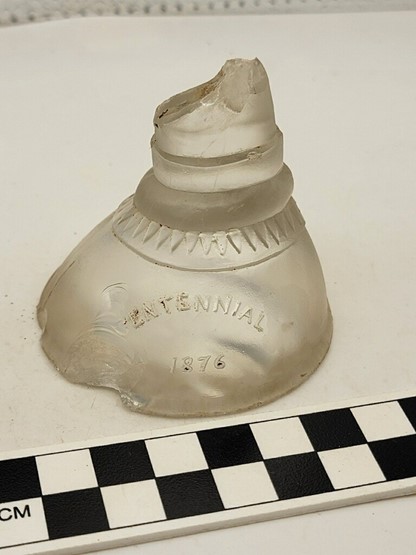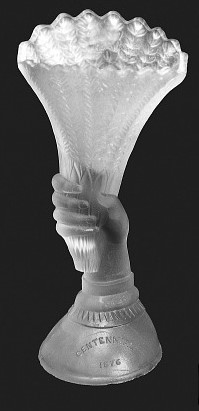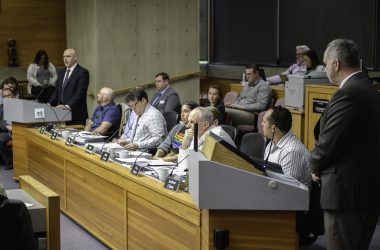From the lab of the Salem’s City Archaeologist: Frosted Glass base; “Centennial, 1876” -3 1/8” x 2 ½”

This glass fragment was found last summer in downtown Salem during the repair of a portion of sidewalk and recovered, along with a number of other bottles and ceramic shards, after obtaining the required Archaeological Permit from the Oregon State Historic Preservation Office.
The date 1876 is clearly visible, along with “Centennial”. One of my Oregon Archaeological Society lab interns, Katie Karmen, completed some initial research to determine what this glass fragment may have been from and discovered that it was the base of a glass vase created by Gillinder and Sons at the 1876 Philadelphia Centennial Exhibition.
The vase is held by the Smithsonian, in their National Museum of American History as part of their collection of souvenirs from the Centennial International Exhibition of 1876. The Gillinder and Sons vase is also held by the Philadelphia Museum of Art (accession #2010-17-19) and cataloged as a “Bud Vase.” The full dimensions of the vase are documented as 17.6 x 8.1 x 6.4 cm (6 15/16” x 3 3/16” x 2 ½”).

I lived in Philadelphia while I attended graduate school at the University of Pennsylvania, so I was intrigued with the connection between Salem and the Centennial Exhibition in Philadelphia in 1876. The Centennial Exhibition was part of a larger celebrations honoring the 100th anniversary of the Declaration of Independence and the founding of the United States in 1776.
The city of Philadelphia, along with the state of Pennsylvania petitioned Congress in 1871 to authorize the Centennial celebration in 1876. An Act of Congress passed on March 3, 1871, established the United States Centennial Commission and further stated that an exhibition of American and foreign arts, products and manufactures be held in Philadelphia in 1876.
The Centennial Exhibition opened on May 10, 1876, and lasted six months on the grounds of Fairmount Park in Philadelphia, overlooking the Schuylkill River. There were 250 pavilions and 7 miles of avenues and walkways. A narrow gauge double track steam railway, 3 miles long, was available for attendees to use to travel within the grounds.
A New York industrial exhibition had been held in 1853 and there had previously been a small regional fair in Philadelphia in 1864, during the Civil War. However, there had never been anything in the United States of this size and scale before. Designers modeled the Centennial Exhibition after the Crystal Palace Great Exhibition in London held in 1851. The Centennial was extremely successful, with almost 10 million people attending from all over the country.

Gillinder & Sons constructed a glassware manufactory on the grounds, just adjacent to the large machinery exhibition building. William Gillinder was born in Gateshead, England in 1823. As a young man, he worked in glass factories in Birmingham and Stourbridge and by 1851 he published a book, “The Art of Glassmaking.” He moved to the United States in 1854 to work for the New England Glass Company in Cambridge, Massachusetts.
In 1861 Gillinder moved to Philadelphia and established the Philadelphia Flint Glass Works where he manufactured coal lamps and chimneys. Gillinder received a patent in 1865 for his Cincinnati pitcher, which was a process of blowing glass which used a combination blowpipe and snap case which allowed a glass pitcher with a handle to be inflated at the same time.
By 1867 a report was published stating the Gillinder factory was the largest glass factory within the city limits of Philadelphia, employing 200 men. illinder died in 1871 at the age of 49, leaving his sons, James and Frederick, in charge of the glass factory. The Gillinder brothers chose to construct an exhibition glass factory for the Centennial Exhibition in 1876.

Inside there was a large melting furnace, which they used to demonstrate how to make their glass.
As reported in the Historical Register of the Centennial Exhibition by Frank Leslie (page 267):
Certainly one of the most constantly attractive centres on the Centennial Grounds was the building where was exhibited the beautiful art of glass manufacturing in all its branches … A single one-storied structure of considerable extent, unbroken by wall or pillar, containing a tall tower tapering in form from the bottom up, and a furnace, comprised the principal portion of the glass-works … About these red-hot furnaces could be seen continually in constant movement a large force of men and boys engaged in stirring up the hot metal within the main furnace, carrying to the various artificers balls of the red mass on the end of their metal sticks and performing other duties involved in the mysteries of glass-making.

Frank Leslie goes on to describe how the glass was then formed into souvenirs that visitors could purchase:
At one side of the building men were engaged in frosting, cutting and engraving, by means of wheels, grindstones and tools… In some cases, designs of flowers, letters or other devices, were transferred to glass by means of little copper wheels; in other instances, articles were engraved, “Centennial, 1876,” and also with the names or initials desired by the purchasers. Among such articles sold in enormous quantities during the Centennial Exhibition in this building were very pretty little glass slippers, paper-weights of different kinds, delicate wine-glasses and tumblers, flower-holders, pitchers and numerous other pleasing souvenirs. Altogether, there were probably no outside exhibitions at the Centennial which attracted so much attention, or perhaps conveyed so much information as that of the Messrs. Gillender.
While our glass base does include the engraving of the date, 1876, and the word “Centennial,” no clear initials are visible. However we will be continuing to curate the collection of glass and ceramics that were recovered, and perhaps we may find additional pieces of this vase that may shed more light upon who it may have belonged to.
As I researched the 1876 Centennial, I was impressed by the overall planning and design of the Centennial Park, which transformed Fairmount Park in Philadelphia with numerous buildings and statues and fountains placed throughout the grounds.
One of the most prominent was the arm and torch of which would become part of the Statue of Liberty. As Frank Leslie describes:
This fragment of the statue was erected on the Centennial grounds, a few rods south of Frank Leslie’s Pavilion, and was observed with interest by visitors. The [full] statue is designed to be placed, when completed, upon Bedloe’s Island, or some other commanding point in New York Harbor. It originated with the people of France, who subscribed liberally for its construction, and being completed by American subscriptions, will become a prominent object on our Atlantic seaboard.
The portion of the Centennial bud vase that we discovered here in Salem appears to reflect the general design and form of this portion of the Statue of Liberty.
To learn more about Philadelphia’s 1876 Centennial Exhibition please visit the Smithsonian Libraries, who have digitized the complete volume of Frank Leslie’s illustrated Historical Register of the Centennial Exhibition 1876: https://library.si.edu/digital-library/book/frankleslieshis00lesl.
Salem’s City Archaeologist is responsible for curating artifacts recovered on City of Salem public property (or in the Right of Way) at the City of Salem’s archaeological lab. I research each artifact’s history and use by Salem’s residents. This information is included in a final report which will be sent to the Oregon SHPO to be added to the Oregon Archaeological Records Remote Access and Archaeology Bibliographic Database, a GIS-based web portal that can be accessed by qualified archaeologists and has information on documented archaeological resources and archaeological survey reports. State law prohibits sharing locational information about known archaeological sites, so no specific geographic location information can be shared with the public. Curation, treatment and education about any recovered indigenous artifacts on City of Salem public property is restricted and handled in consultation with the tribes. If you come across a historic or indigenous artifact, please leave it in place and contact the City Archaeologist at [email protected] or 971 718-7221.
STORY TIP OR IDEA? Send an email to Salem Reporter’s news team: [email protected].
SUPPORT OUR WORK – We depend on subscribers for resources to report on Salem with care and depth, fairness and accuracy. Subscribe today to get our daily newsletters and more. Click I want to subscribe!
Kimberli Fitzgerald is the city of Salem's archeologist and historic preservation officer. She is a regular contributor to Salem Reporter's local history column.









